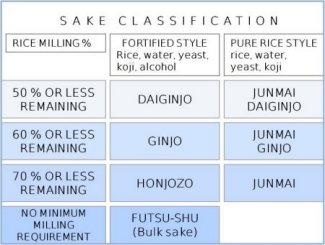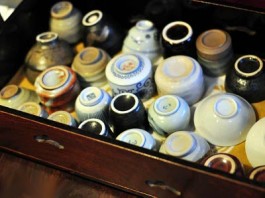Did you know that October 1st is National Sake Day in Japan? This is the day the brewmasters all across the country begin to produce their sake. This is an occasion for us, North-Americans, to learn a bit more about this unique Japanese beverage. Sake is brewed like beer, and consist of 3 ingredients: rice, water, and yeast. Sake is made of premium sake rice not table rice. Price and flavours relate to the polishing ratio of the rice kernel, and higher the polishing the more refined the flavour, and higher the price.
Sake classifications influence both the taste and price of a bottle of sake. The chart below outlines the classifications by ingredients and rice milling rate.
JUNMAI GINJO Sake is brewed using only rice, water, yeast and koji. There are no other additives. To qualify as a Ginjo, the rice kernel mustbe milled to at least 60% of its original size. GINJO Sake is the same as Junmai Ginjo except a small amount of distilled brewer’s alcohol is added to the sake to achieve different flavour profiles.
JUNMAI Sake is brewed using only rice, water, yeast and koji. There are no other additives. To qualify as a Junmai, there is technically no minimum milling requirement but the sake must be pure rice style, and no distilled alcohol allowed. HONJOZO Sake must be milled to at least 70% of its original size and as far as ingredients go, it contents a small amount of distilled brewer’s alcohol to achieve different flavour and aroma profiles.
What is koji? Koji is steamed white rice onto which a mold, called kohi-kin, has been cultivated. This mold works its way into the rice kernel releasing enzymes to create sugar which will determine how sweet, dry, rich or light the sake will be.
TASTE AND FLAVOUR
Tasting sake is just like tasting wine and other beverage, many things will have an effect on how a sake tastes and smells. Temperature is one example. Sake can have many flavours notes such as apples, bananas, melons flowers, herbs, spices, rice, dry grapes etc. The fragrance of sake can be simple fruit, flower, rice, and the texture can be soft, firm lively or quiet. Finally, unami is a term that has worked its way into the western culinary world. Unami refers to a hard to pint point tastiness, goodness, and is more an intuitive sense of taste.
SERVING SAKE
In Japan sake is served chilled, at room temperature or heated, depending on the preference of the drinker, the quality of the sake, and the season. Typically, hot sake is a winter drink, and high quality sake is not drunk hot bedause the flavours and aromas will be lost. Sake is usually drunk from samll cups called choko, and pour from a ceramic flask called tokkuri.
COCKTAIL
Another celebration day to enjoy an alcoholic beverage, I’ll drink to that! Sake can be used as a mixer for cocktails such as the Saketini. Try this simple and delicious Saketini that combines the fresh fruit flavour of Junmai sake with the aromatic Blue Saphire gin.
Kunpai!
Micheline



